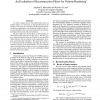Free Online Productivity Tools
i2Speak
i2Symbol
i2OCR
iTex2Img
iWeb2Print
iWeb2Shot
i2Type
iPdf2Split
iPdf2Merge
i2Bopomofo
i2Arabic
i2Style
i2Image
i2PDF
iLatex2Rtf
Sci2ools
97
Voted
VISUALIZATION
1994
IEEE
1994
IEEE
An Evaluation of Reconstruction Filters for Volume Rendering
To render images from a three-dimensional array of sample values, it is necessary to interpolate between the samples. This paper is concerned with interpolation methods that are equivalent to convolving the samples with a reconstruction filter; this covers all commonly used schemes, including trilinear and cubic interpolation. We first outline the formal basis of interpolation in three-dimensional signal processing theory. We then propose numerical metrics that can be used to measure filter characteristics that are relevant to the appearance of images generated using that filter. We apply those metrics to several previously used filters and relate the results to isosurface images of the interpolations. We show that the choice of interpolation scheme can have a dramatic effect on image quality, and we discuss the cost/benefit tradeoff inherent in choosing a filter.
Related Content
| Added | 09 Aug 2010 |
| Updated | 09 Aug 2010 |
| Type | Conference |
| Year | 1994 |
| Where | VISUALIZATION |
| Authors | Stephen R. Marschner, Richard Lobb |
Comments (0)

